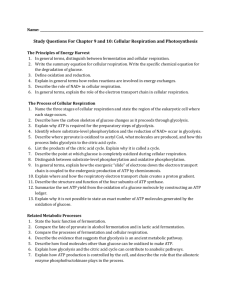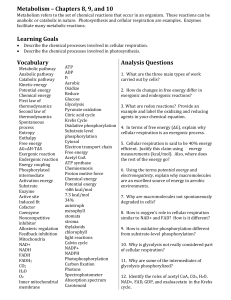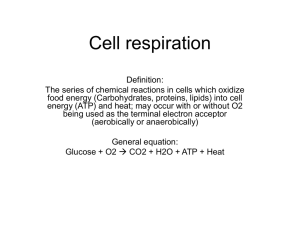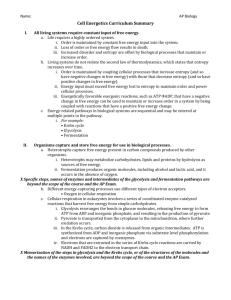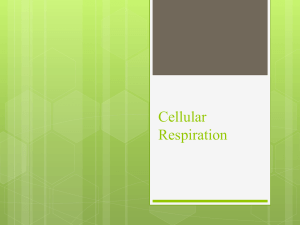Ch. 9: Cellular Respiration & Fermentation AP Reading Guide
advertisement
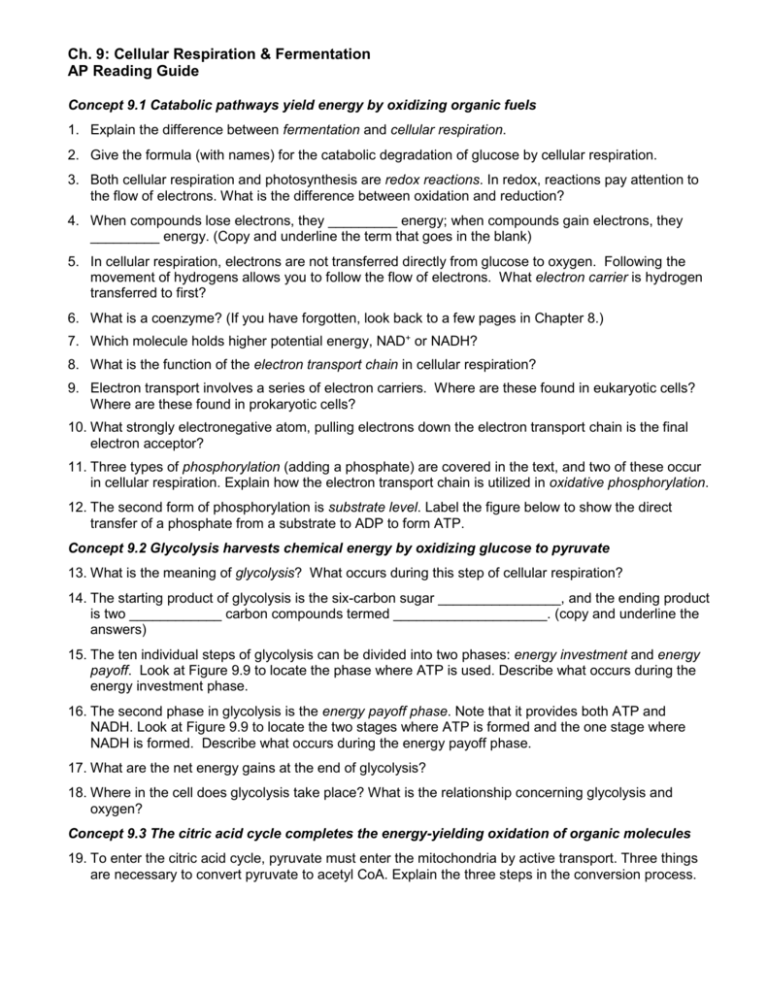
Ch. 9: Cellular Respiration & Fermentation AP Reading Guide Concept 9.1 Catabolic pathways yield energy by oxidizing organic fuels 1. Explain the difference between fermentation and cellular respiration. 2. Give the formula (with names) for the catabolic degradation of glucose by cellular respiration. 3. Both cellular respiration and photosynthesis are redox reactions. In redox, reactions pay attention to the flow of electrons. What is the difference between oxidation and reduction? 4. When compounds lose electrons, they _________ energy; when compounds gain electrons, they _________ energy. (Copy and underline the term that goes in the blank) 5. In cellular respiration, electrons are not transferred directly from glucose to oxygen. Following the movement of hydrogens allows you to follow the flow of electrons. What electron carrier is hydrogen transferred to first? 6. What is a coenzyme? (If you have forgotten, look back to a few pages in Chapter 8.) 7. Which molecule holds higher potential energy, NAD+ or NADH? 8. What is the function of the electron transport chain in cellular respiration? 9. Electron transport involves a series of electron carriers. Where are these found in eukaryotic cells? Where are these found in prokaryotic cells? 10. What strongly electronegative atom, pulling electrons down the electron transport chain is the final electron acceptor? 11. Three types of phosphorylation (adding a phosphate) are covered in the text, and two of these occur in cellular respiration. Explain how the electron transport chain is utilized in oxidative phosphorylation. 12. The second form of phosphorylation is substrate level. Label the figure below to show the direct transfer of a phosphate from a substrate to ADP to form ATP. Concept 9.2 Glycolysis harvests chemical energy by oxidizing glucose to pyruvate 13. What is the meaning of glycolysis? What occurs during this step of cellular respiration? 14. The starting product of glycolysis is the six-carbon sugar ________________, and the ending product is two ____________ carbon compounds termed ____________________. (copy and underline the answers) 15. The ten individual steps of glycolysis can be divided into two phases: energy investment and energy payoff. Look at Figure 9.9 to locate the phase where ATP is used. Describe what occurs during the energy investment phase. 16. The second phase in glycolysis is the energy payoff phase. Note that it provides both ATP and NADH. Look at Figure 9.9 to locate the two stages where ATP is formed and the one stage where NADH is formed. Describe what occurs during the energy payoff phase. 17. What are the net energy gains at the end of glycolysis? 18. Where in the cell does glycolysis take place? What is the relationship concerning glycolysis and oxygen? Concept 9.3 The citric acid cycle completes the energy-yielding oxidation of organic molecules 19. To enter the citric acid cycle, pyruvate must enter the mitochondria by active transport. Three things are necessary to convert pyruvate to acetyl CoA. Explain the three steps in the conversion process. 20. Use Figure 9.11 to answer the following summary questions about the Krebs cycle: a. How many NADHs are formed? b. How many total carbons are lost as pyruvate is oxidized? c. From which molecule are the carbons lost? d. How many FADH2 have been formed? e. How many ATP are formed? f. How many times does the citric acid cycle occur for each molecule of glucose? 21. The step that converts pyruvate to acetyl CoA at the top of the diagram (fig. 9.11) also occurs twice per glucose. This step accounts for two additional reduced ____________ molecules and two carbon dioxide molecules. (copy and underline answer) 22. Explain what has happened to the six-carbon molecules found in the original glucose molecule. Concept 9.4 During oxidative phosphorylation, chemiosmosis couples electron transport to ATP synthesis 23. Oxidative phosphorylation involves two components: the electron transport chain and ATP synthesis. Referring to Figure 9.13, notice that each member of the electron transport chain is lower in free __________ than the preceding member of the chain, but higher in _______________. The molecule at zero free energy, which is __________, is lowest of all the molecules in free energy and highest in electronegativity. (copy and underline answers) 24. Oxygen is the ultimate electron acceptor. Why is this? 25. Oxygen stablilizes the electorns by combining with two hydrogen ions to form what compound? 26. The two electron carrier molecules that feed electrons into the electron transport system are ________________ and __________________. (copy and underline answers) 27. Using Figure 9.14, explain the overall concept of how ATP synthase uses the flow of hydrogen ions to produce ATP. 28. What is the role of the electron transport chain in forming the H+ gradient across the inner mitochondrial membrane? 29. Two key terms are chemiosmosis and proton-motive force. Relate both of these terms to the process of oxidative phosphorylation. 30. Figure 9.15 is a key to understanding the production of ATP in the mitochondria. Draw and label all a diagram showing chemiosmosis. Then use one color to trace the flow of electrons and another color to show the flow of protons. 31. At this point, you should be able to account for the total number of ATPs that could be formed from a glucose molecule. To accomplish this, we have to add the ATPs formed by substrate-level phosphorylation in glycolysis and the Krebs cycle to the ATPs formed by chemiosmosis. How many ATPs can be made from one NADH? How many ATPs can be made from one FADH2? 32. Why is the total count about 36 or 38 ATP molecules rather than a specific number? Concept 9.5 Fermentation enables some cells to produce ATP without the use of oxygen 33. Fermentation allows for the production of ATP without using either __________ or any ___________ ______________________________. (copy and underline answers) 34. For aerobic respiration to continue, the cell must be supplied with oxygen—the ultimate electron acceptor. What is the electron acceptor in fermentation? 35. Alcohol fermentation starts with glucose and yields ethanol. Explain this process, and be sure to describe how NAD+ is recycled. 36. Lactic acid fermentation starts with glucose and yields lactate. Explain this process, and be sure to describe how NAD+ is recycled. 37. Using Figure 9.19 as a guide, draw and explain why pyruvate is a key juncture in metabolism. Concept 9.6 Glycolysis and the citric acid cycle connect to many other metabolic pathways 38. What three organic macromolecules are often utilized to make ATP by cellular respiration? 39. Explain the difference in energy usage between the catabolic reactions of cellular respiration and anabolic pathways of biosynthesis. 40. Study figure 9.20, and explain how AMP stimulates cellular respiration while citrate and ATP inhibit it. 41. Phosphofructokinase is an allosteric enzyme that catalyzes an important step in glycolysis. Explain how this step is a control point in cellular respiration.


